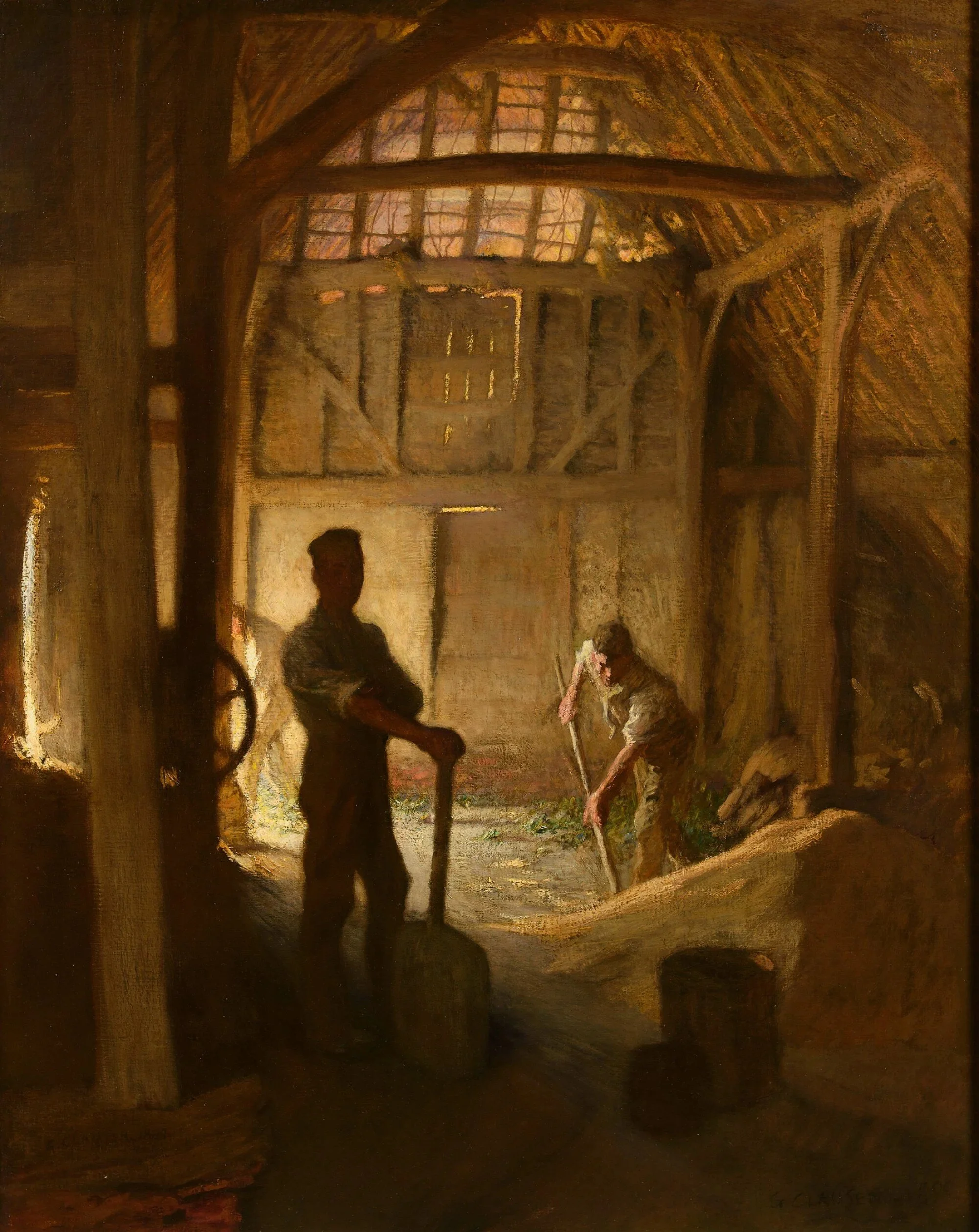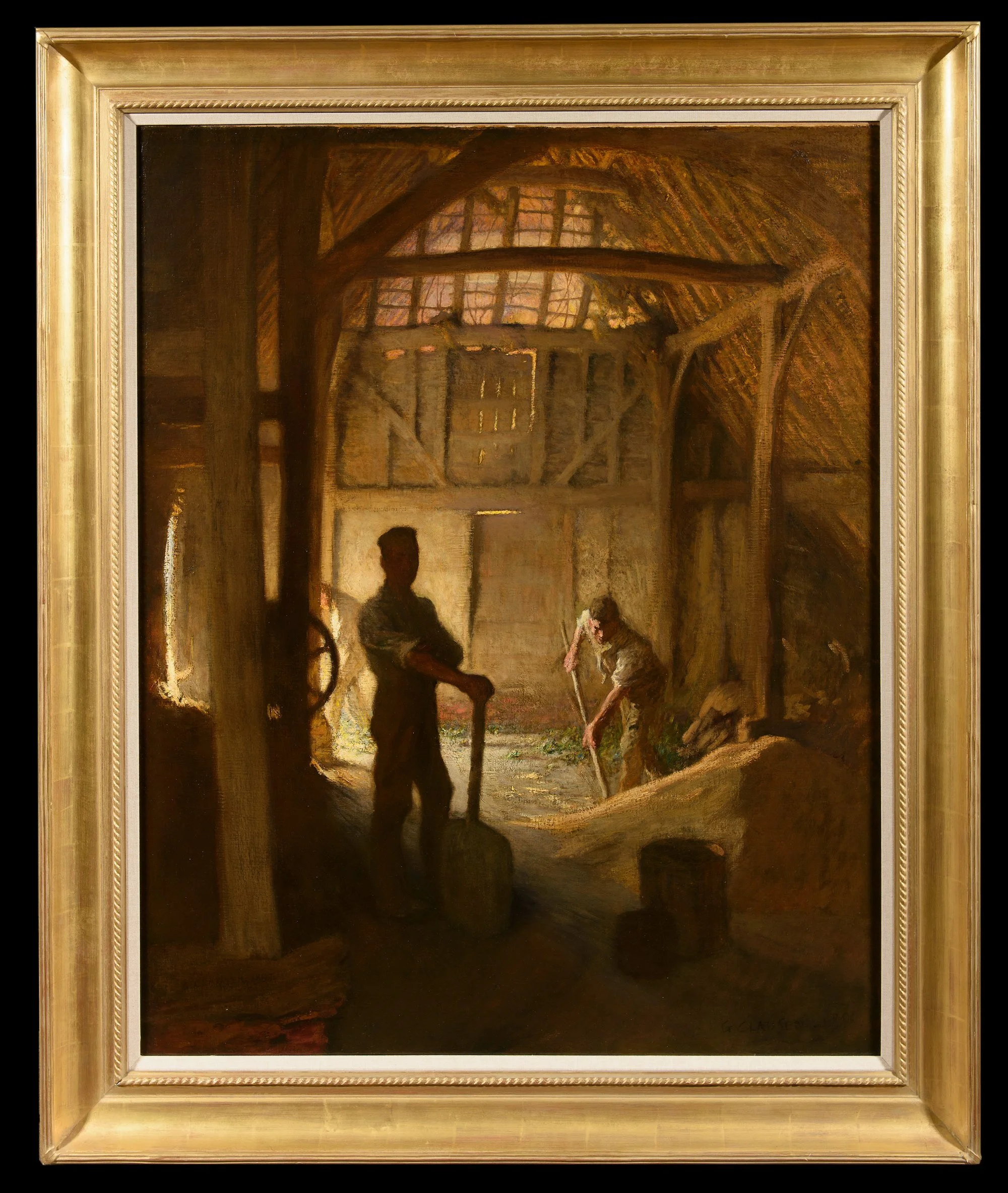The Old Barn, 1896 by Sir George Clausen


The Old Barn, 1896 by Sir George Clausen
Barn and stable interiors appear in Clausen’s sketchbooks as early as 1884, but it was not until 1897 that the first in a long series of such subjects was exhibited at the Royal Academy. This painting, The Old Barn, contrasts a farmer leaning on a stick in the middle distance with a man working in the background.
DIMENSIONS: (unframed) 42.3 x 34.0 ins/ 107.5 x 86.4 cm (framed) 51 x 42 ins/ 129.5 x 106.7 cm
SIGNATURE: Signed ‘G Clausen’ and dated (lower right); signed and dated ‘G. CLAUSEN.1897’ (lower left)
MEDIUM: Oil on canvas
Price: £84,000
Sir George Clausen was a founder-member of the New English Art Club (NEAC) and was the most widely respected of the NEAC painters, promoting the interests of the Glasgow Boys, such as James McNeil Whistler.
Barn and stable interiors appear in Clausen’s sketchbooks as early as 1884, but it was not until 1897 that the first in a long series of such subjects was exhibited at the Royal Academy. This painting, The Old Barn, contrasts a farmer leaning on a stick in the middle distance with a man working in the background.
Clausen’s Diploma work was admired by contemporary critics for its atmospheric lighting. The chiaroscuro is pronounced, with the nearest figure seen only in silhouette. Perhaps influenced by his work in pastels, the painting is highly coloured, with light entering the barn from both the side and the rear, and blue highlights showing on the man and ground. The brushwork is free and uninhibited.
Provenance
Property of a Charitable Trust;
Private collection, United Kingdom
George Clausen’s oeuvre is hugely diverse in style, but unwavering in its sensitivity and effective technique. Clausen was enormously inspired by the countryside, and turned to painting genre scenes and portraits of ordinary land workers. This drawing is likely to be a preparatory sketch for a painting such as this. It depicts a farm hand walking, mid stride, with a scythe over one shoulder. The liberal way in which the figure has been drawn implies that the artist may in fact have been working from life.
Clausen was born in London in 1852, his mother was Scottish and his father was from Denmark. Clausen’s father was artistically minded, and was employed as an interior decorator. Clausen at first followed in his father’s trade but in 1867 began to attend evening classes at the National Art School, which is now the Royal College of Art, in South Kensington. There he studied under the painter Edwin Long and it was Long who convinced the younger painter to pursue art as a full time career.
In 1875 Clausen travelled to Holland and Belgium where he became influenced by Dutch naturalism. In 1881, he married Agnes Webster and the couple lived in Berkshire where the surrounding countryside provided the artist with rural inspiration for his work. In 1882 Clausen left for France where he studied briefly at the Académie Julien, Paris. While there, he visited the studios of French Salon painters, including Clus-Duran. In France Clausen became interested in the out-of-doors realism of Juels Bastien-Lepage. On return to England, Clausen formed the New English Art Club in 1886 which adhered to the French style of painting en-plein-air. The artist was elected ARA in 1895 and RA in 1908. From 1903-6 he was appointed to the position of Professor of Painting at the Royal Academy. He received many honours during his lifetime. In 1893 Clausen was awarded an honorary membership in the Art Workers Guild and during World War I he served as an official war artist. In 1927 he was knighted.
Literature
Royal Academy Illustrated, 1897, p. 27.
The Academy Notes, 1897, Chatto and Windus, p. 6 (illustrated).
ACR Carter, ‘The Royal Academy 1897’, The Art Journal, 1897, p. 174.
‘Chronicle of Art – May’, The Magazine of Art, 1897, p. 47.
Art at the Royal Academy, London, 1897 (Studio Special Number), p. 45 (illustrated).
‘The Royal Academy – Second Notice’, Dundee Courier, 6 May 1897, p. 4.
MH Spielmann, ‘The Royal Academy II’, The Graphic, 8 May 1897, p. 570.
Kenneth McConkey, Sir George Clausen, RA, RWS, 1980, exhibition catalogue, Bradford, Bristol and Newcastle Art Galleries and Royal Academy of Arts, p. 70 (illustrated as untraced).
Kenneth McConkey, George Clausen and the Picture of English Rural Life, Edinburgh, 2012, fig. 205, p.125 (illustrated as unlocated p. 126).
Exhibitions
London, Royal Academy, 1897, no. 52.